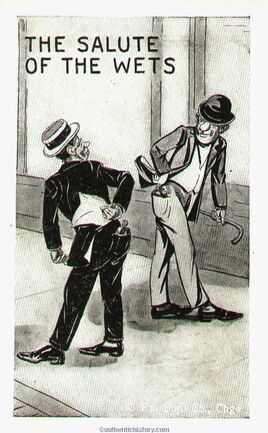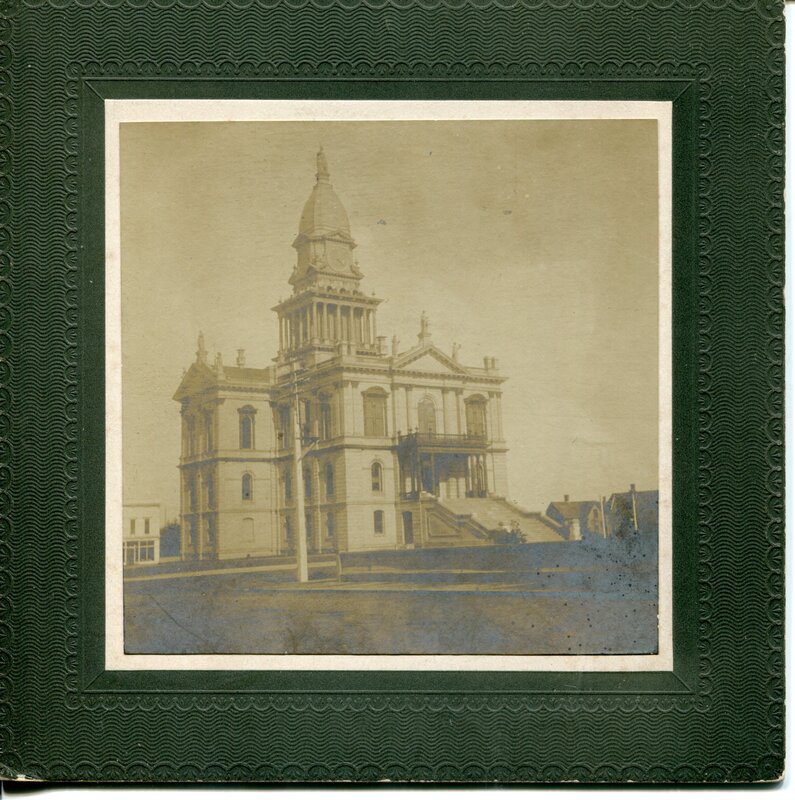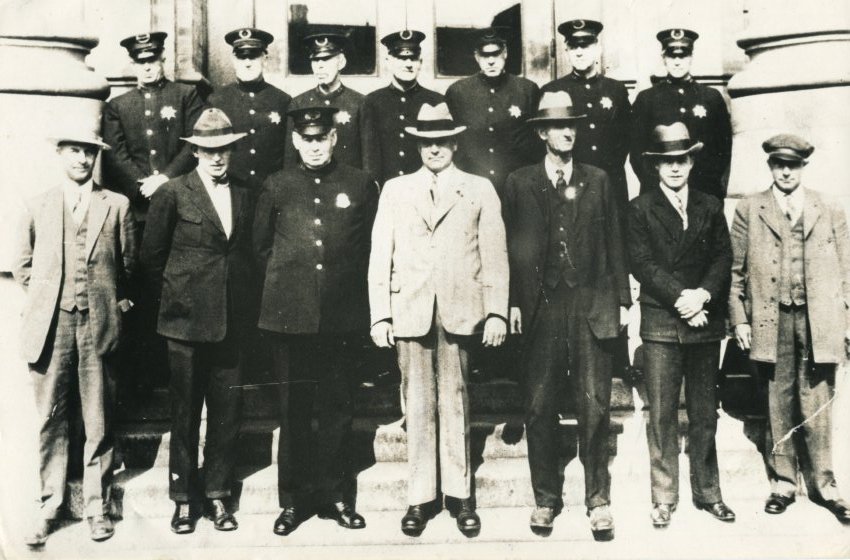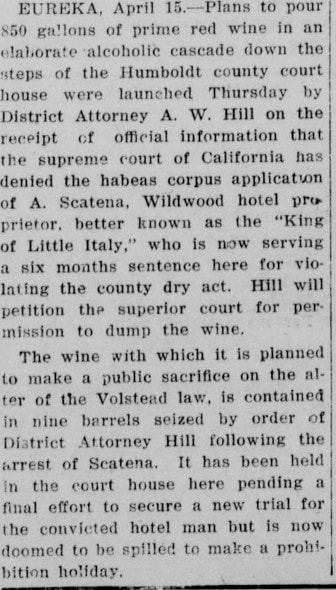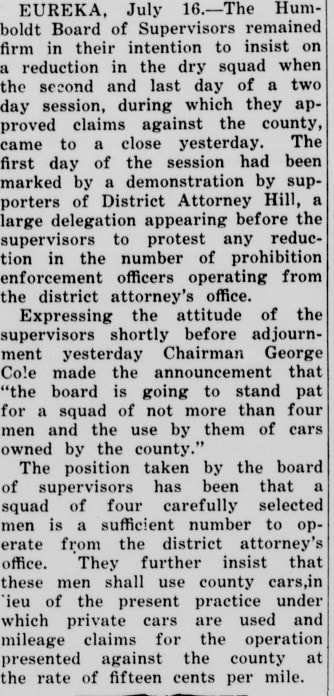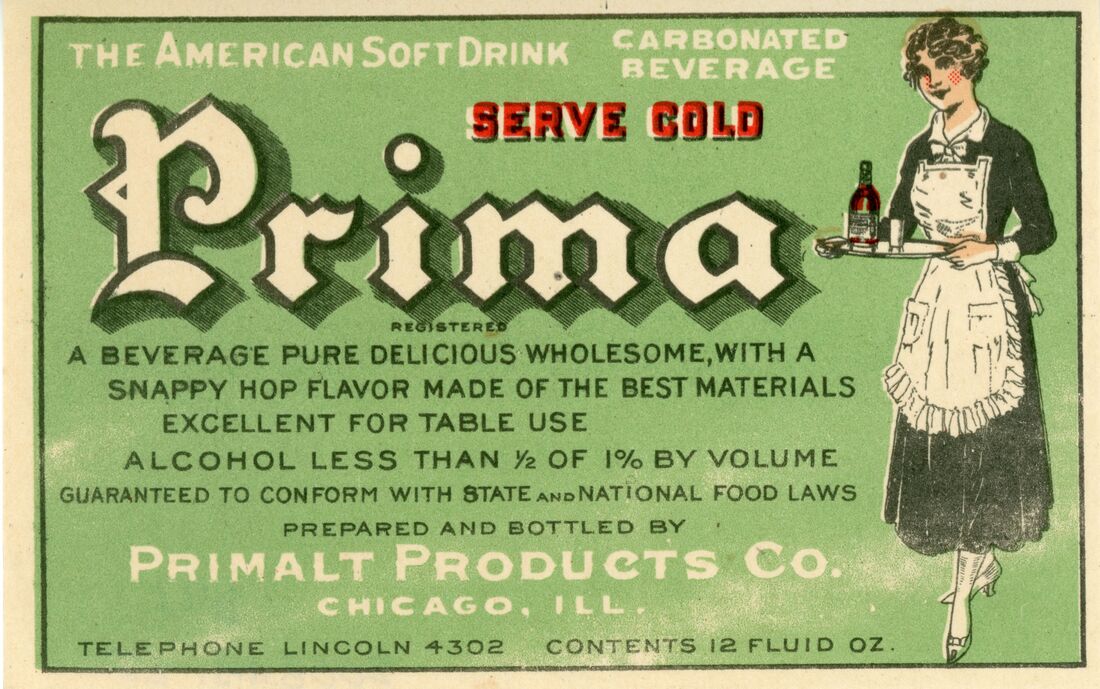Whiskey in the Wall
Law and Disorder in Prohibition Era Humboldt County
1920-1933
Prohibition was a national policy, but it was not enforced uniformly and did not turn out as planned. While proposed to be a way to cultivate lawfulness and improve lives by the removal of alcohol (and was strongly influenced by religious reasoning), it inverted expectations and has become part of the national mythos surrounding freedom of choice. It affected Humboldt County’s settlement patterns, lifestyles, and the criminal records of many- not to mention entering the local lore of many towns in the county. We can see that in stories from our region’s experience with prohibition.
Origins of Prohibition
|
Supporters of Prohibition included the local Protestant denominations, primarily the Methodist and Presbyterian churches, along with the Women’s Christian Temperance Union, which had branches locally. The International Order of Good Templars was also present and active locally, campaigning against liquor and in support of alcohol prohibition at the city level before national prohibition occured. The Anti-Saloon League, known for nationally teaming up with any organization that supported the prohibition of alcohol (which included groups across the political, social, and national spectrum including the NAACP and Ku Klux Klan), was also active locally, and began organizing around 1906 to forge a campaign in Humboldt County. An announcement for the league’s arrival stated “The anti-saloon league of this county is now laying the foundation preliminary to an active campaign… it is American in principle and practice.” What prompted this push back against alcohol?
|
|
There are a few different levels to the anti-alcohol movement- at the surface, alcohol had a reputation of becoming an addiction to men in many households. Alcohol helped dull the pain of manual labor and the stress of poverty, both of which were rampant and common in places like Eureka and the plethora of mill towns throughout the county. Bars also served as meeting places for friends, unions, and other social groups, so alcohol had a social draw, much like how it does now. Some men, upon drinking too much, became violent. Violence strained family life, led to serious conflicts, destitution and even death to spouses and children. It was believed the prohibition of the sale of alcohol would bring those violent domestic disputes to an end, bettering family life and the life of the community.
|
Another layer of this is that the prohibition era was during the post-millennial era- a period in Christian theological thought where it was believed that the second coming of Christ (and the Judgement Day at the end of time) would arrive when the earth had been cleansed of sin. While the United States itself is not an officially Christian nation, since its founding, it has been widely influenced by Christian ideas and ideals, a trend that continues today. These post-millennial ideas fueled the Progressive Era at the turn of the century, affecting the lives of Christians and non-Christians alike. Many Christians in government or leadership positions influenced their colleagues to rally for policies that would promote social harmony and repair communities, cleansing the world of sin in preparation for Christ's second coming and the judgment day at the end of time. The Prohibition movement was part of that preparation and was promoted widely by churches across denominations.
|
In Humboldt County, prohibition came earlier than the national prohibition. In 1910, rural areas of the county voted to be dry. As the idea caught on locally and nationally, town by town votes were held to make the towns “dry” or “wet”. In 1912, an article was published claiming “All Humboldt Towns Vote to remain Wet excepting Fortuna”. In these elections, women came out to support the cause of prohibition in droves. The combined number of women who were registered to vote in Arcata, Ferndale, Blue Lake and Fortuna was 867. 779 women voted, a roaring 89% of those who were eligible to do so. By 1920, the 18th amendment and other statewide policies made prohibition the standard- in theory.
|
"You Couldn't Tell the Difference"
|
In the black market for liquor, the difference between good and bad became incredibly blurry. Policemen, charged to uphold the law, knew that there was little to no federal presence to enforce Prohibition, so a contingency of policemen took advantage of the situation. A scout in southern Humboldt would pick out bootleggers bringing alcohol from out of the area, reporting their appearance to the local police, who would pull them over, and tell them their jail time would be waived if they handed over their illegal liquor. The policemen would then take the liquor to a vault in Ocean Grove Cemetery, where it would be stockpiled and resold within the city. Local lore also says that confiscated liquor was kept under the staircase at the old County Courthouse- where it could be quickly accessed by county staff especially the judges. Liquor in these hiding places that went bad, such as wine that turned to vinegar, was supposedly used in public demonstrations of alcohol dumping in the street to parade the farce that the police were enforcing prohibition- one story claims a barrel of red wine was dumped down the stairs of the old Courthouse in celebration of a frequently fined bootlegger finally being imprisoned.
|
|
There was a group, known as the County Dry Squad, that was employed by the county to enforce Prohibition in county land, which had “gone dry” before the more urban areas had. The Dry Squad appeared widely in the newspapers, frequently shutting down rural stills and operations while the urban police refused to enforce the law in city limits. There were movements in Eureka to reduce the size and effectiveness of the Dry Squad through questioning its legality, defunding, and shrinking the maximum size of the squad.
|
|
The first female Mayor of Eureka, Emily Jones, sought to uproot the corruption that had grown during prohibition within the police force by firing the men involved- however the new hires continued the corrupt practice of confiscating liquor and even asking for bribes. There was even a situation where a local news editor impersonated a cop to receive bribe money, and other situations where local police were seen imbibing illegal liquor at local establishments. Emily Jones began removing corrupt officers, however with every one that was fired, a new corrupt one would take their place. With no decline in prohibition period lawlessness, a recall election was held to pressure Emily Jones to step down from being mayor, supposedly because she couldn’t enforce prohibition. In the end, she received a job offer to work for the State of California, which she took and left Eureka. Many of the initial crooked cops that Emily Jones removed were reinstated near the end of Prohibition. A quote from Emily Jones on this period in time is “you couldn’t tell the difference between the gangsters and policemen, that was true everywhere”.
|
Incredible Finds
|
While the making, sale, and transportation of alcohol may have been illegal during the prohibition period, people across the country continued to make, sell, and transport alcohol- and were incredibly tricky about how they went about it. Bootleg alcohol was a moneymaker and those who took the risks to make and sell it wanted to be sure they got their money’s worth. In 1932, one of the largest illegal distillery busts in the state happened on Willow Brook Ranch. The Department of Justice found a 200 gallon still along with 3,000 gallons of 180-proof alcohol, which had been packaged in 5 gallon tins ready for shipment. The report stated that the distillery size was comparable to commercial distilleries that operated before prohibition. (Humboldt Times, 26 July 1930).
|
On June 8, 1926, the Ocean House at 3rd and C Streets in Eureka was raided due to suspicion that it was a distribution point for illegal liquor. After a thorough search that didn’t yield any evidence, the investigator turned knobs on the stove in a last ditch effort- the four stovetop dials turned on burners, but the oven knob didn’t- instead liquid dripped out of the knob. It turned out that there was a pipe through the stove connecting to a tank in the wall behind the stove. This tank measured 6 feet tall, 11 inches wide, and 4 inches thick- and could hold almost 2,000 gallons of liquor (Humboldt Standard).
|
Humboldt County made national news near the end of prohibition when a liquor running group based out of Canada was caught shipping liquor through Humboldt Bay and loading it to trains in Scotia headed for the Midwest just in time for the holiday season. The first shipment caught totaled $2,420,806.71 in 2018 dollars and the second shipment caught a few days later was worth $1,862,000 in 2018 dollars. It’s believed the group had been moving liquor through the county for a couple of months before being caught.
|
Wildwood
|
Part of current-day Rio Dell has some of its earliest roots in the Prohibition Era. One family, the Rovai family, arrived in Wildwod around 1908, when Domenico Rovai lost his job in the Scotia mill due to his bootlegging of whiskey to make extra money after work. Wildwood at this time was an assemblage of homes on the opposite side of the Eel River from Scotia. The community included families from around the same area in Italy, and over time, more families moved to the area. Saloons, pool halls and “houses of ill-fame” popped up in Wildwood, while a bustling community grew up alongside.
The area gained its title as Wildwood in the early 20s as a hub for bootleg liquor, and the chaos that came with the rise of prohibition in Humboldt County. Author Julio Rovai, who wrote a book on his life in Rio Dell in the 1920s stated “the community was entirely without law”. A. Scatena, known as the King of Little Italy, was a bootlegger who constantly showed up in the newspapers for being arrested for bootlegging, having his wine confiscated, paying the $500 fine (which is about $7,500 in 2018 dollars), and being released. One arrest led to prison time for Scatena, and the prohibition-enforcing District Attorney proposed a celebration for the event- dumping hundreds of gallons of wine confiscated from Scatena down the County Courthouse steps. |
The Saga of Stephen E. Metzler and John Lennon
Stephen E. Metzler was the District Attorney and John Lennon was the County Detective near the beginning of prohibition in the county. By 1930, however, Metzler, Lennon, and 10 other people from Humboldt County were headed to federal court under the charge of conspiracy to violate the national prohibition laws. What happened?
|
From Healdsburg Tribune, 1925, 5 months before Metzler took office.
|
In 1926 Stephen E. Metzler was elected into the office of District Attorney after representing a newspaper reporter Alfred Lindsley, a newspaper editor who was in prison for contempt of the court following the publication of an article against the county dry squad. Judge Sevier fined Lindsley $2000 ( about $28,000 in 2018 dollars) and gave him 1000 days in prison, which many thought to be an excessive reaction to the charges. The district attorney representing the city along with Judge Sevier were both up for reelection, but both were replaced due to the outcome of the trial and public opinion directed against the current judge and District Attorney. (Lindsley was later sent to federal prison for a year after impersonating a federal agent to extract bribe money from bootleggers). That election year saw a number of known bootleggers elected to various city and county offices. Metzler planned to do what he could to take the teeth out of prohibition enforcement by reducing the size and effectiveness of the county Dry Squad, as local police officers were already in the business of not enforcing prohibition.
One of Metzler's first actions as district attorney was to appoint a new County Detective who was not a still-smashing prohibition supporter. His first choice was T. P. Magilligan, who was facing charges of criminal libel from W. A. Markham from election campaign articles Magilligan published in his newspaper The Humboldt News. Metzler later settled on John Lennon as County Detective.
|
|
According to court documents from Lennon and Metzler's indictment in 1930 and their appeal in 1933, Lennon hired a man named French to operate a large still on Lennon's property known as Flannagan Ranch that put out 800 to 1,000 gallons of liquor, and Lennon would move the liquor from the ranch at night. This operation had begun in 1925, before Lennon was appointed County Detective, and continued once he was appointed. Not only did Lennon move his own liquor, but he also sold liquor that had been confiscated in his detective work. Lennon and Metzler were also in the business of asking for bribes from other bootleggers in exchange for protection. Part of that agreement was that the bootlegger would turn themselves in for prosecution, a fine, or possible jail time (done by either the bootlegger or someone else who would go to prison on behalf of the bootlegger) if the public began to complain too loudly about lack of prohibition enforcement. It was also known that bootleggers who didn't pay for protection were liable to raids and prosecution by the District Attorney and County Detective.
|
Outside of all that, there were also multiple reports of Metzler drinking alcohol in his office and Lennon driving a county vehicle while drunk.
Lennon and Metzler were arrested with 10 other individuals from Humboldt County and were tried in Colusa in 1930 under conspiracy to violate the national prohibition laws. Metzler and Lennon were the only ones to serve time in federal prison however. They tried to appeal the decision, but it was upheld. Both men served their time in prison and fade from the newspaper record afterwards.
Medicinal Alcohol- and Keeping Alcohol at an Arms Length
|
Contrary to popular belief, all alcohol was not outright banned during Prohibition, and it wasn't illegal to consume alcohol. Certain quantities could be produced in the home for home use specifically as long as it was declared to the authorities before production. Many medical remedies for illnesses and ailments contained alcohol (some with startling amounts of it), and many doctors prescribed wine to treat a variety of problems. Also, wine produced before the 18th Amendment was legal to possess, however if it was found in a raid, it was confiscated until the age could be verified.
|
|
|
Alternative drinking products that attempted to encourage a temperate lifestyle and to fill the formerly alcohol filled taps at bars that could now no longer serve alcohol abounded in the prohibition period. It's unclear whether or not they were as tasty as advertisements said they were. Some companies continued to produce products that could be turned into alcohol in the privacy of one's home, and included warning labels to encourage consumers to not produce alcoholic products over the legal alcohol limit.
|
Prohibition in Decline
Prohibition drew to a close in the early 1930s with the onset of the Great Depression. People didn’t have extra money for alcohol like they used to. Money flowing to distilleries and bootleggers slowed down, making it a much less lucrative business. Distilling was expensive to set up and notoriously risky, so many got our of the business or moved to bootlegging smaller amounts of alcohol. It became a less profitable business, and the number of arrests and fines for the illegal activities declined. It came to a point where the declining fine revenue began to have an effect on local police funding, which had benefited during the heydays of prohibition.



